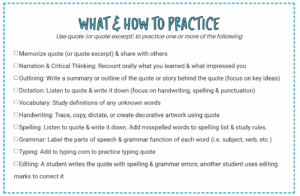
Throughout the centuries, powerful writers have inspired, amused and profoundly altered the way we view ourselves, others and the world. Great writers are people that have something interesting or important to say and share that information in compelling ways. The following tips can help as you inspire & teach your children to become great writers.
Remember, learning to write starts before a child can hold a pencil. Authors are remembered not for the grammar rules they memorize, but by the thoughts they share with the world. Even young children can share profound, powerful messages that change others. Good writing can’t come out of an empty brain. There must be ideas, information, experiences, feelings or opinions the person wants to share. Cultivating creativity, learning to synthesize information, sharing ideas with others, thinking critically, asking questions, pondering and meditating are all important aspects of writing that start at an early age. Create a home and school environment that encourages these characteristics and builds a child’s confidence that they have something worth sharing.

Not only is it important to develop your own ideas, but also to learn from others. Reading quality literature is a critical component of learning to write. It may seem counter-intuitive, but if you want your child to write well, first teach them to love reading. Children learn from example. The more a child reads, the more “writing mentors” they can look up to and ideas they have to draw from. Not all books are created equal. If a child reads books that are written poorly, they are likely to mimic that style and language. If they never branch out and read on a variety of topics, they are likely to struggle when writing within different disciplines.
Completing lots of worksheets does not mean a child will become a good writer. When we enjoy listening to a speaker or reading something, it is not just because the person has something to say. Almost everyone has something to say. It is also because they can express themselves well. Successful writers can communicate in a way that is clear, easy to understand and engaging. Their writing has “personality”. Completing worksheets may teach a child some of the mechanics of writing, but that does not necessarily translate into children becoming great writers. Unlike math or science, where you can pretty much use a check-off sheet or a test to tell if the student knows the material or not, writing is much more open-ended. So how do you measure improvement or progress? How do you know when your child is on track? Three important milestones can help you evaluate your child’s progress.
Writing Milestones
1. Ability to write basic ideas. The child can put something down on paper and have others understand what they were trying to communicate. I’ll never forget the first time my child gave me a picture with the words, “I love you” written on it. It’s hard to know if it was more exciting for them or for me! They clearly communicated something important to them in writing.
2. Writing fluency. Writing starts as a very laborious process, but gets easier the more you do it. Eventually, writing just flows rather naturally. From an early age, get your kids excited about communicating with others through writing so they will write, write, write. Have them write in journals and do real world projects that have meaning. Whenever possible, have them share their ideas and projects with others. An over emphasis on worksheets, especially at an early age, can kill a child’s love for writing and cause them to never develop writing fluency. You know your child is a fluent writer when they can easily and consistently put their thoughts on paper in a clear, understandable way and they are excited to do so.
3. Engaging writing and good craftsmanship. Writing fluently is an important milestone in writing, but is not the end goal. Children also need to learn to express themselves well. A surprising amount of craftsmanship can be learned just by completing writing projects, getting feedback and then making revisions. However, more focused, in depth topical study is also generally required. As children learn to think about and analyze their thoughts, they must learn to put them together in a logical way that makes sense to others. That is where learning to outline becomes so powerful. Outlining helps refine and support ideas with specific information, examples or antidotes that give depth and perspective. Improving writing craftsmanship is a life long quest that is multifaceted. However, there is a specified list of skills that should be mastered. These include a variety of different writing structures, grammatical concepts & stylistic elements. Simply Smart provides a list of these concepts so you can keep track of your child’s progress. A good sign your child is becoming a really good writer is when people are drawn to their writing in a way that inspires them and keeps them wanting to read more.
The Nuts & Bolts of Teaching Writing
Everyone has limited time, so focus your energy on the activities that provide the greatest dividends. Be efficient. Over the course of home schooling for thirty years, we have found the following four components to be the most important for developing successful writers (along with continually reading quality literature).
1. Journal & Devotional. This daily activity is short and impactful. It teaches children to ponder, meditate, think critically, ask questions, share ideas and helps develop writing fluency. There are many ways to structure devotionals, but some important components we have found are: a) have children read and ponder sacred (or other) texts each day and write down their thoughts and impressions, b) keep a daily journal of their life and c) share their thoughts from their personal devotional with the family each night.
2. Words to Remember. A lot of benefit can be gained by studying the words of successful writers in depth using shorter passages. Study: 1) important documents, 2) historical speeches, letters and journals, 3) poems and songs, 4) literary excerpts and 5) sacred texts (if religious). As children get older, a good goal is to study and memorize one passage a week and then share it with others. The great thing about Simply Smart’s Words to Remember program is it is flexible and easy to relate to whatever else you are studying. The following skills and activities can be used in conjunction with the quotes found in the program.

3. Writing Projects. Regularly have your child complete a writing project and then share it with others by giving presentations to a co-op, creating your own “kids magazine”, enrolling in competitions and fairs, etc. As children get older, they can complete a smaller writing project once a week, or larger projects over the course of several weeks. Writing projects are specific assignments or activities that focus on mastering particular writing skills and methods of organization. Simply Smart writing projects use a “template” approach that helps the student visualize how the project is to be completed. The projects are applicable for multiple ages and abilities, and can be used over and over by varying the topic. No specific order must be followed, but children should rotate between different types of projects so they master them all.
4. Grammar & Style. The mechanics of writing is what many people think of when someones says “language arts”. When teaching grammar & style, be efficient. Rather than doing endless busy work, focus on teaching the specific skills your child needs and then incorporating concepts into weekly writing projects and Words to Remember activities. Grammar & style lessons should be completed as children continue to work on writing projects. You can spread grammar units out over several years, or complete them in a short period of time. Simply Smart provides a list of each skill that should be developed. The important thing is that at some point your child learns everything listed and that you are teaching the concepts your child needs in order to keep progressing as a writer. Part of the mechanics of writing also includes spelling, handwriting and typing.
- Spelling lists should focus on the words your child is personally getting wrong when they write. This improves writing faster, speeds memorization & increases retention. Teach children the phonetic rules behind the words they mispell. Often times a child will mispell several words because they do not understand the rule. Teaching the rule can sometimes help a child learn how to spell many words at once.
- Handwriting basics are taught in Simply Smart’s Phonics program. However, handwriting should continue to be practiced as children complete writing projects & Words to Remember assignments.
- Typing helps children write quickly. Our family has enjoyed typing.com. This program allows you to enter your own quotes from the Words to Remember program as you practice.
Teaching writing doesn’t have to be hard. The important thing is to get children writing and keep them writing. Challange them to refine their thoughts, ideas and compositions. Learning to write is like eating an elephant. Just keep taking one small bite at a time.
RELATED ARTICLES

Is there something you would like help or more information on? Submit your questions here.
Do you have a parent help article that you want Simply Smart to consider publishing? Share by clicking here.
- Date Added: August 25, 2025



